The Pope was the driving force behind his hectic schedule right to the end.
Behind the scenes, there was a respectful battle of wills between Pope Francis and his team of doctors who urged him against returning to his papal engagements too soon after leaving Rome’s Gemelli hospital where he spent five weeks being treated for double pneumonia.
Doctors prescribed two months of rest – the pope did anything but that.
Pope dies latest: King Charles leads tributes
It became clear when the pope left the hospital on 23 March that the papacy had changed – it would have to be less dynamic and more prophetic.
In other words, the pope’s hallmark desire to be among the people would have to be tailored to his need to be on oxygen.
He was urged to stay away from exposure to the outside elements and potential infections.
The expectation was that he would lead spiritually, but largely not be seen or hold many meetings.
A modest but doggedly determined character, doctors said he “had the brain of a 50-year-old” just weeks ago, in spite of his ailing body.
But tracking the pope’s movements over these past weeks, he clearly followed his heart’s desire to get back to work – even moving about in an open vehicle the day before his death among the Vatican Easter crowds.
Pope Francis would have loved that.
A hint of how his personality would dictate events came on the day he was taken into hospital, Friday 14 February.
By then, he was struggling with a respiratory tract infection, and his doctors said he needed to go to hospital.
Okay, said the pope, but not before he had gone ahead with and concluded a planned meeting with the Slovak prime minister.
On the Sunday before that – and by now struggling with a cold – he defied those who warned against the cold and wet of an early February day to lead prayers outdoors.
Read more:
Pope Francis obituary
A pontiff’s life in pictures
How is the pope chosen?
In the end, the pope’s death was sudden and came as a shock – in spite of his long hospitalisation.



